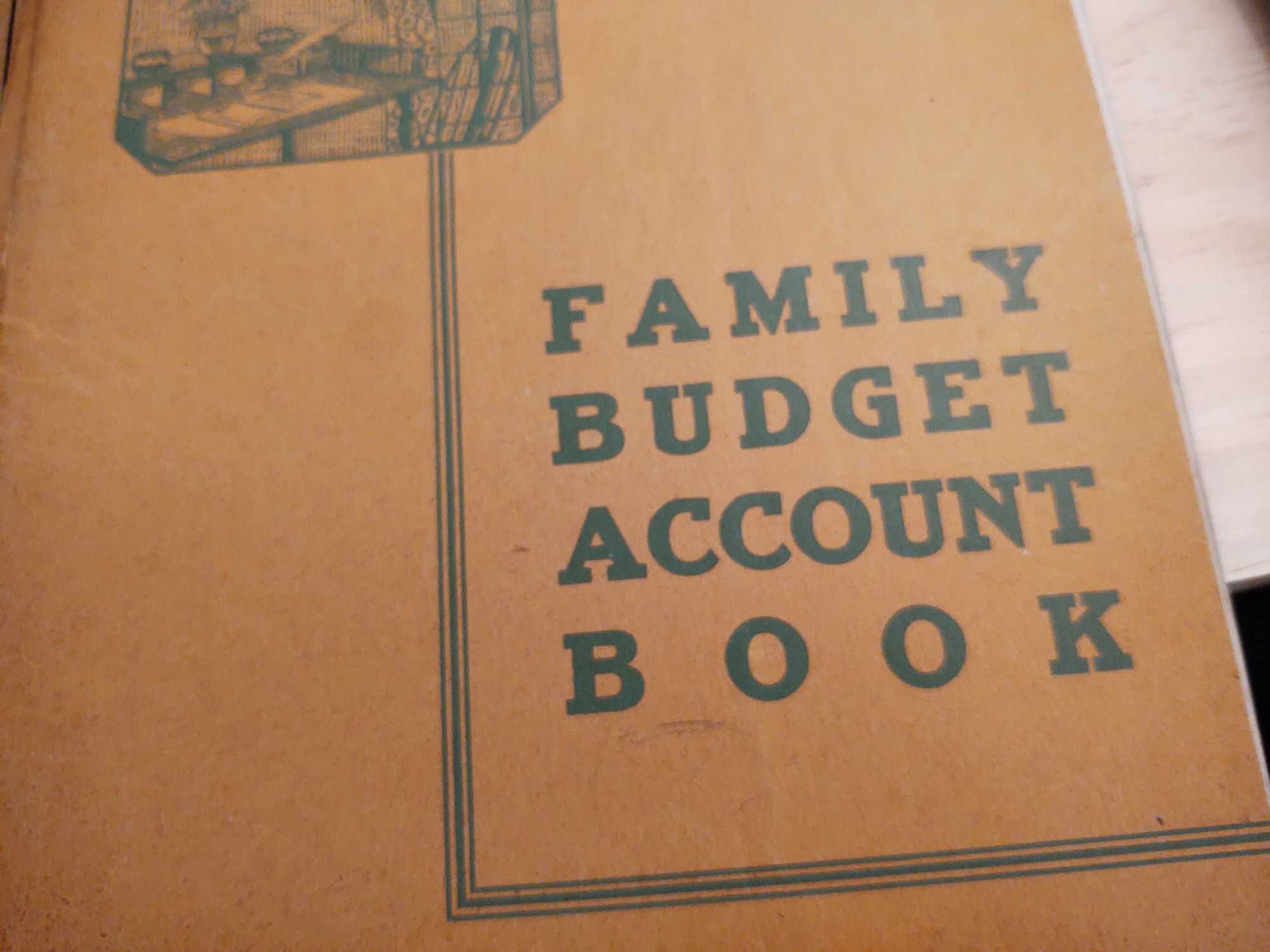
This Budget is going to be much more than just a budget. I feel that we are living in a time that we need to give much thought how to go forward, and at least for Charles and I, going backwards is what is making sense.
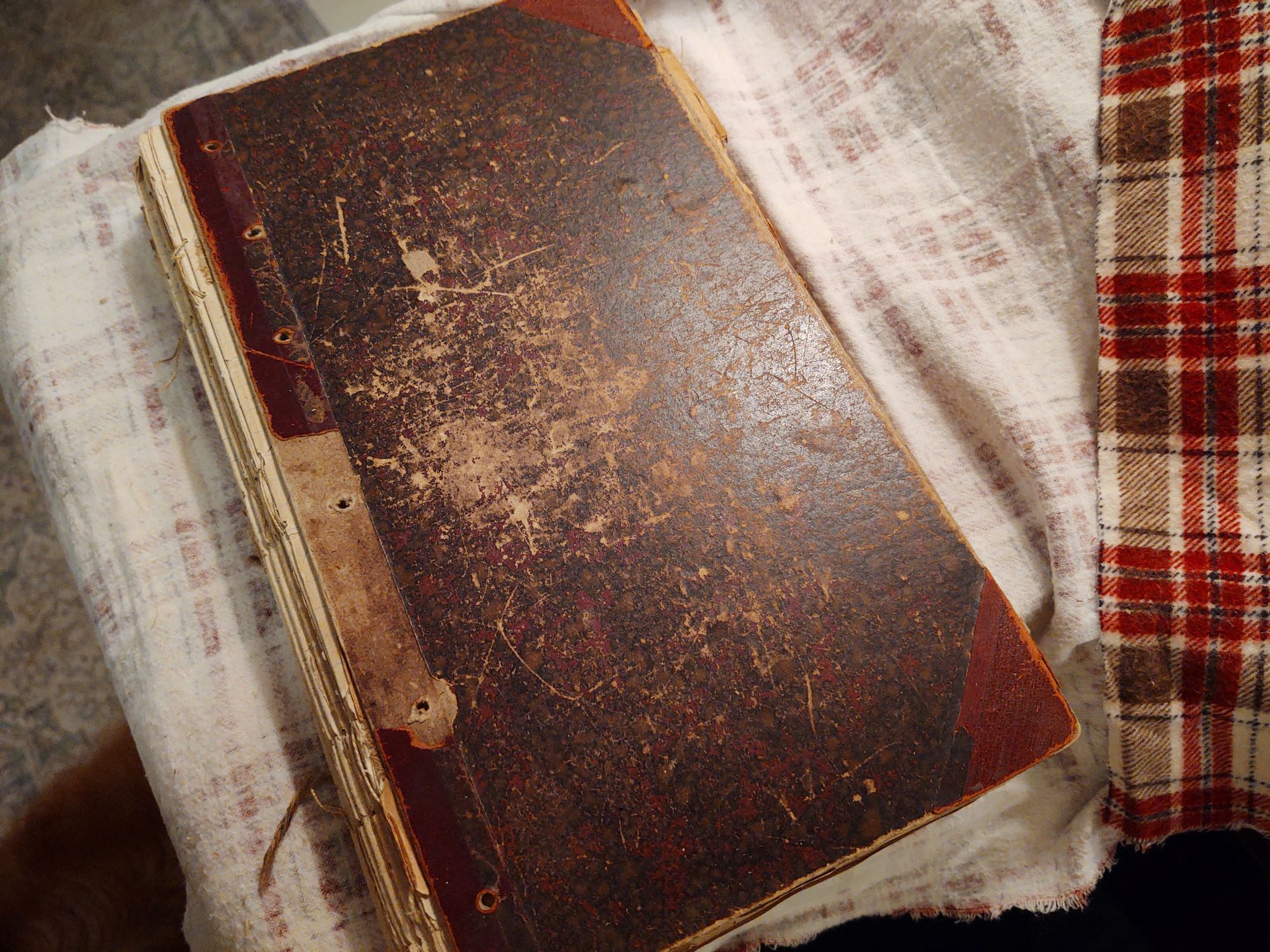 I have been studying pieces of history in handwritten diaries, journals and budget books, old letters and years of shredding older family members bills and paperwork that they never got rid of. After their death it was left to us to discard their paperwork. I have been reading the old newspapers on microfilms and years of asking questions to people older than I am.
I have been studying pieces of history in handwritten diaries, journals and budget books, old letters and years of shredding older family members bills and paperwork that they never got rid of. After their death it was left to us to discard their paperwork. I have been reading the old newspapers on microfilms and years of asking questions to people older than I am.
Today I see many people struggling with finances and it is not a wonder why. We are living in a time that much of everything is inflated and when people are having to put groceries on a credit card and cannot go to the doctor when they need to because they cannot pay the high fees we are in trouble.
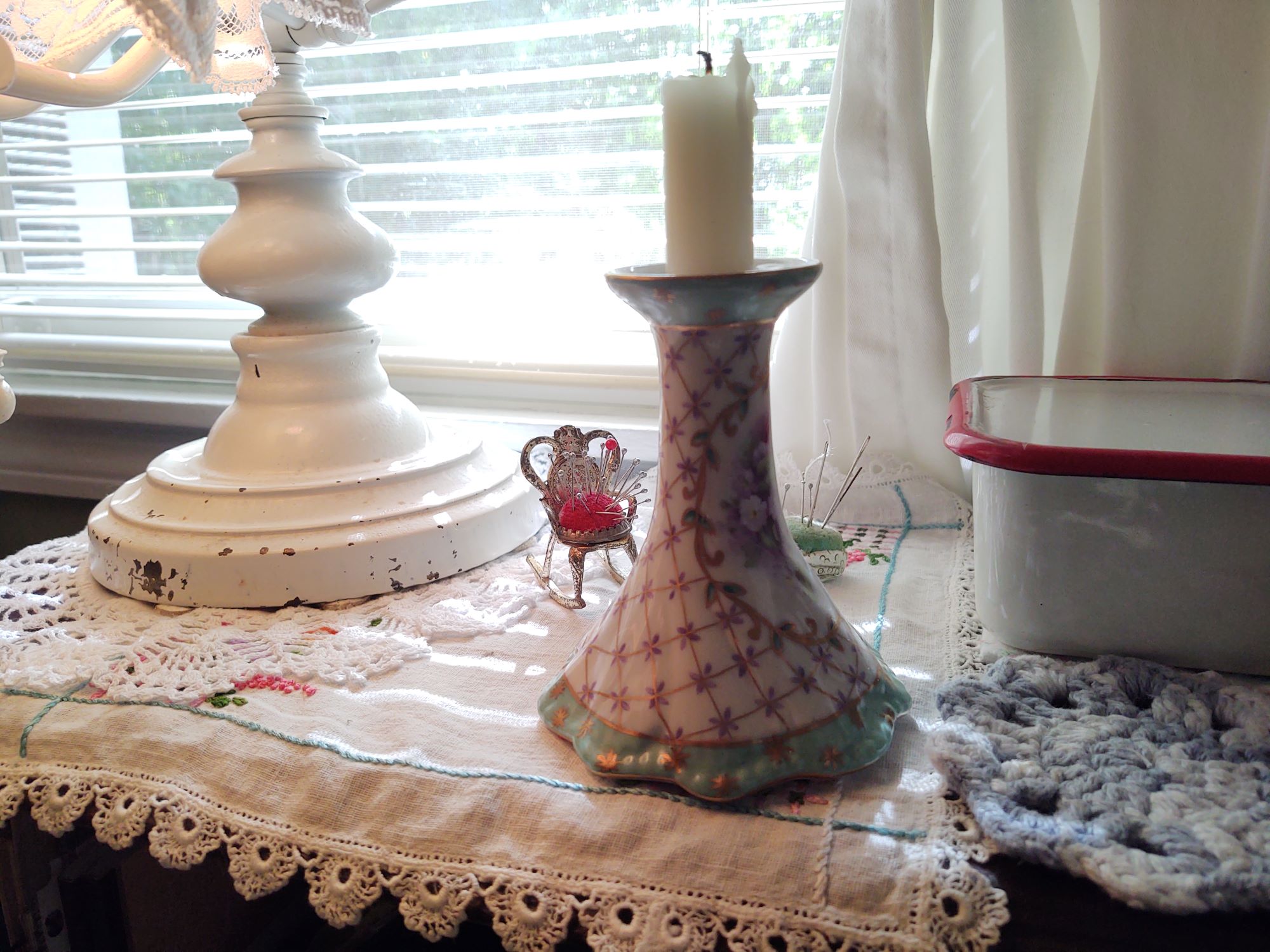
Let us start somewhere and that somewhere is right in our home.
First, we need to face the reality that if we are going in debt each month just because we cannot pay cash or pay our normal bills then it is time to stop all spending. There is nothing that we cannot fix, and there is a solution to everything. I am not going to say that it might not be what we want but there is a solution.
If we have any debt at all we need to get out of debt and the only way to do this is to stop doing things the same way we have been doing.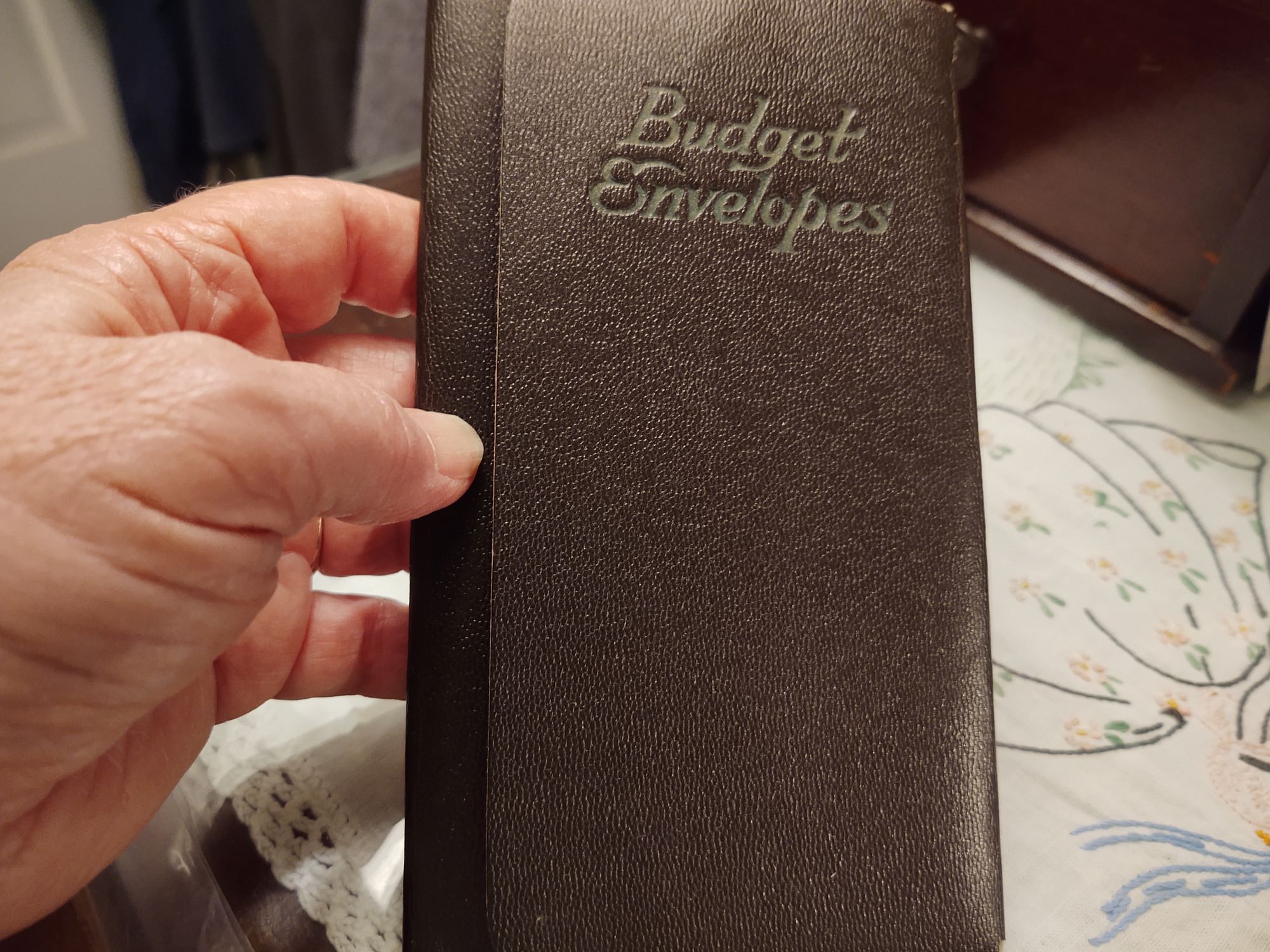
This is a very old 1940s budget envelope system binder. Inside this small budget binder is where we start.
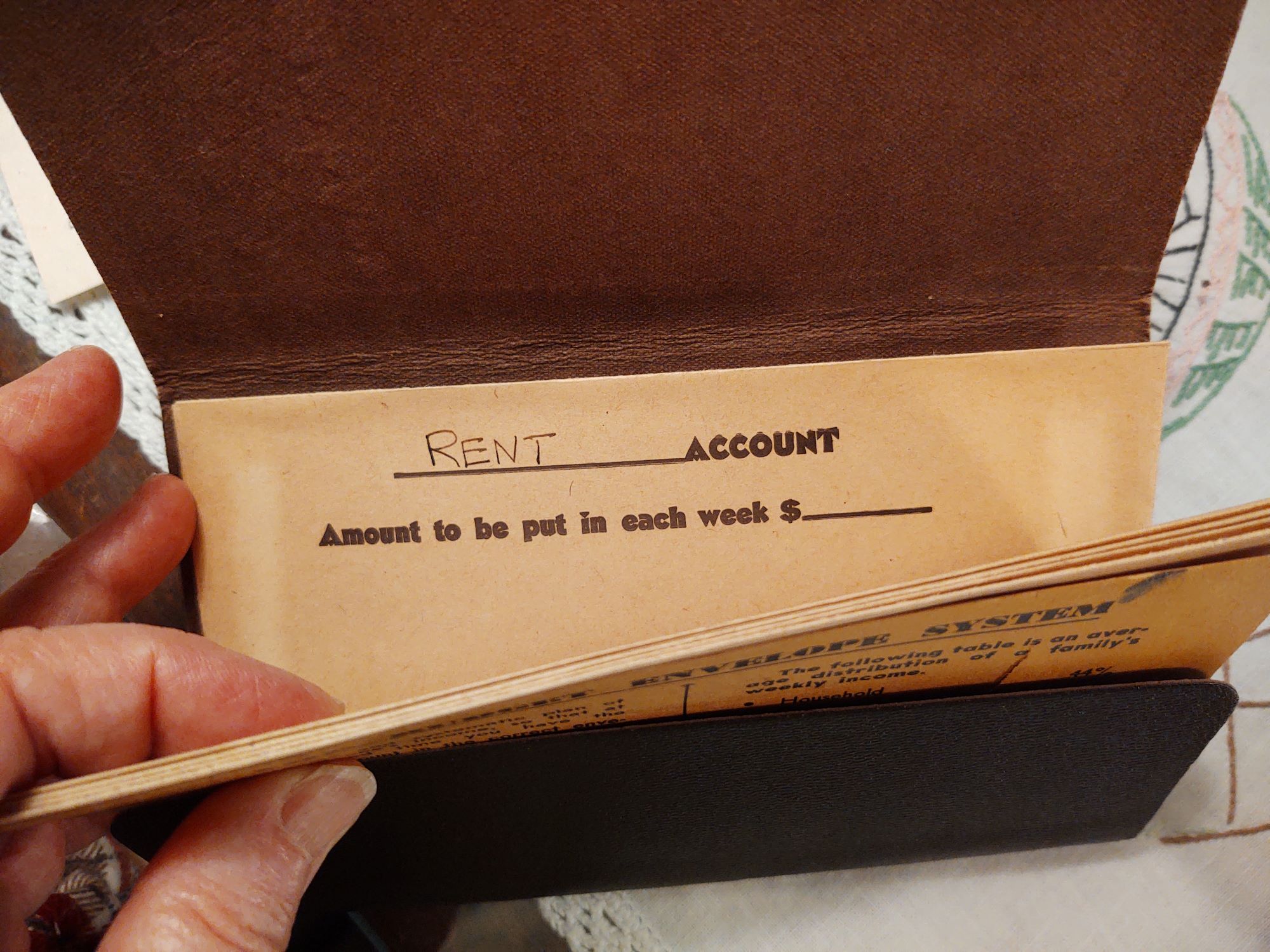
This little vintage pouch holds envelopes 3 & 3/4 x 6 & 1/2 inches. Here in the U.S. this is a normal size of a regular size mailing envelope.

They are stacked together and stapled into the cover. I put a piece of paper so as to not distract from the two staples because this is important.
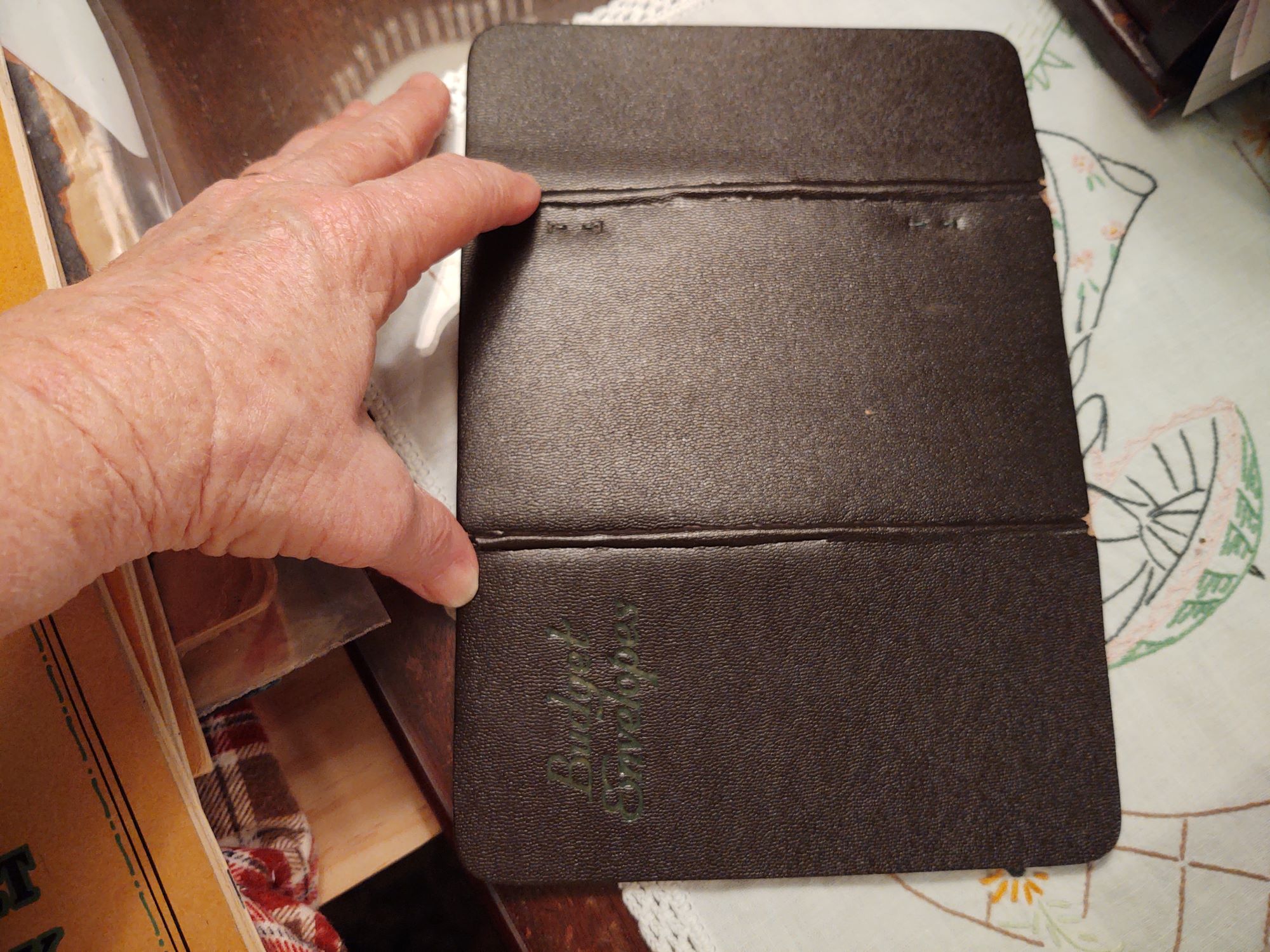
The staples are holding the envelopes into this binder. You can see the backside of the staples. There are seven envelopes in this little binder.
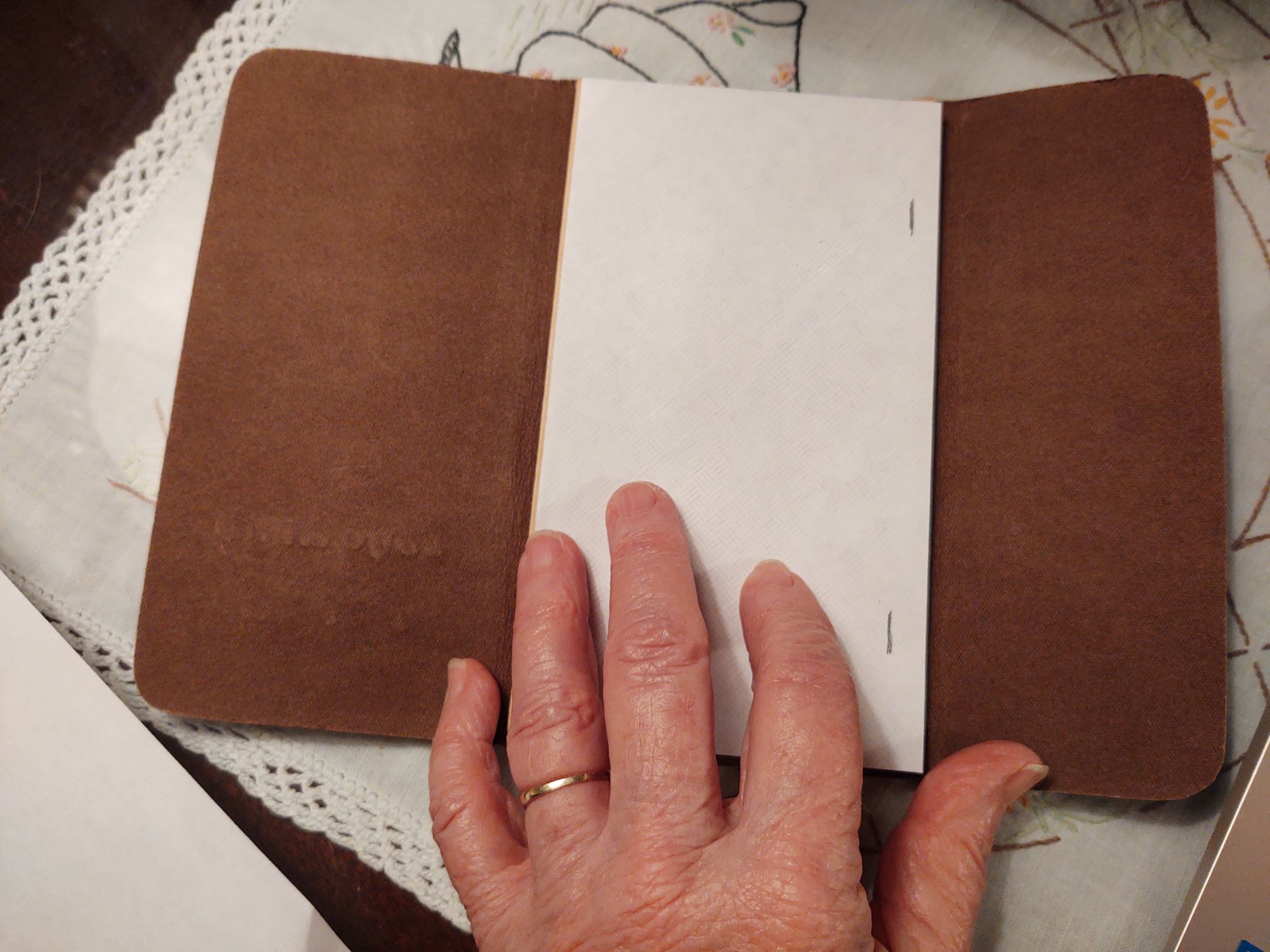
A very simple system. It can be made from cardboard, you can get creative and glue or sew some pretty cloth, you can draw on the cardboard or if you have some leather make a really nice one. It is up to your imagination. I placed a white regular size envelope on top of the older tan colored envelopes and drew a pencil mark to show where it is stapled. At the bottom of the envelope and the flap down.
The flat brown cover is a solid piece 9 & 3/4 inches by 6 & 3/4 inches.
I am suggesting making this envelope binder first because we have a lot to do and we need this. There are many envelope systems ready made but we do not want to spend any money and make this homemade binder ourselves.
Some of you already do the envelope system and that is good, this is only part of fixing our budget.
We are going to distribute money into the envelops and we will talk about this later. First we need to make our envelop binder. If you don't have a stapler maybe you can sew where the staples go. Get creative and share what you have made in the forum.
Remember this is a 1940 budget, let's give it a try.
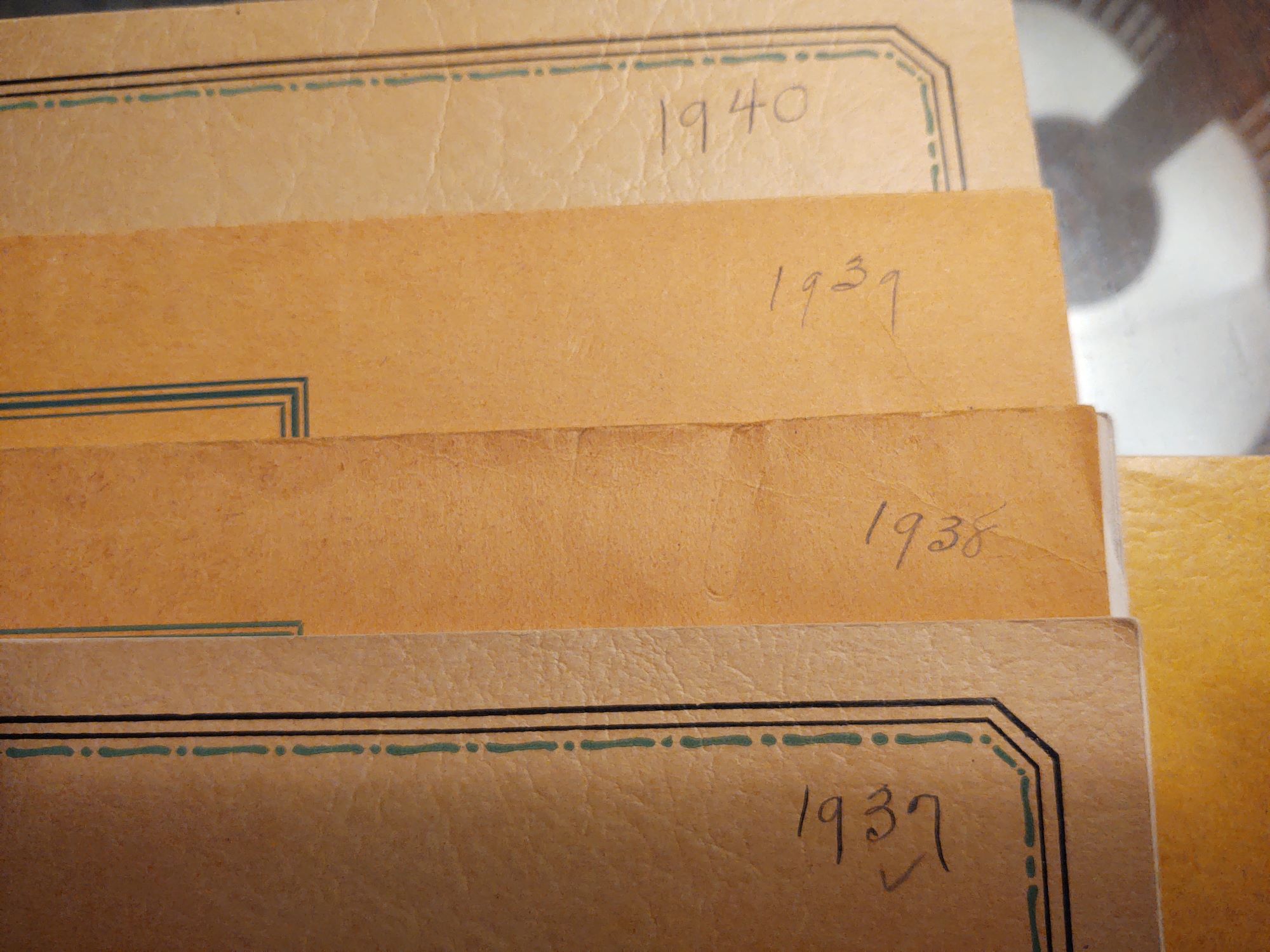
Now the budget story. How I am trying to get the 1940 as factual as possible. The photo above is of 4 budget books completely filled out from a family during this time.
For years I have tried to figure out the best budget book. I finally found a budget book that had been completely filled out and in the year 1940. With that book came three other books, the three years leading up to 1940.
I knew we needed to learn the difference in what they spent their money on in 1940 and what we spend our money on in 2024. But I needed to know more, and I needed to know who these people were writing this budget book and where did they live? The one thing missing is they did not put their income in the budget book, just expenses and what they had saved in the back of the books. We needed to know their income.
They had expenses that we do not have and we have expenses that they did not have. I had no clues who they were except in the back of the book they listed four columns, Mother, Daddy, Gladys and Leon.
Charles and I looked over every entry, trying to get a sense of how they lived and what they spent their money on.
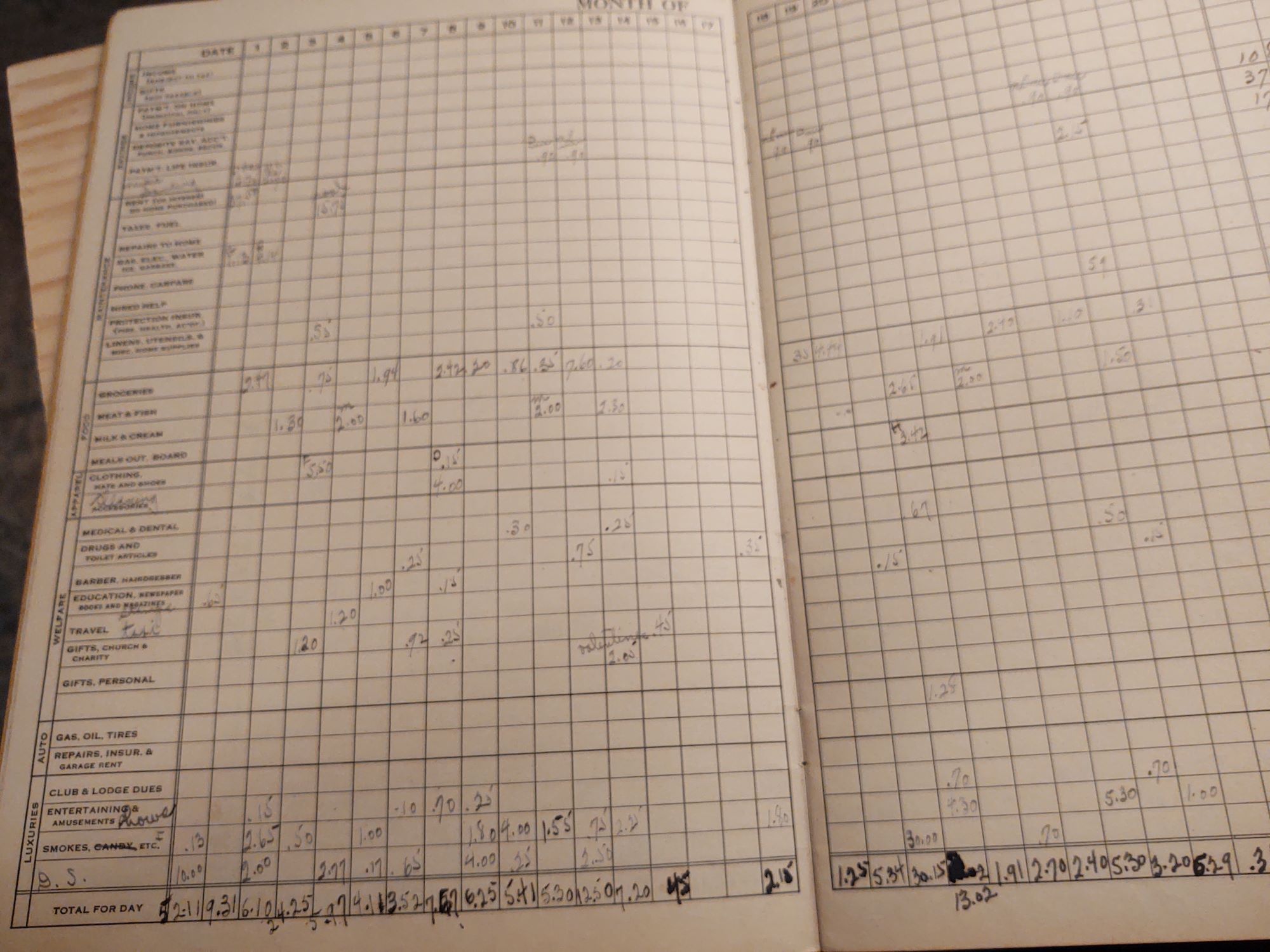
The days of the month go across the page numbered 1 - 31. Each day purchase amounts can be entered in categories. When this budget is opened it is 15 inches across and 10 & 3/4 up and down. Closed 7 & 1/2 X 10 & 3/4

To the left is a column which includes categories.
First category is Income then Savings and then Maintenance.
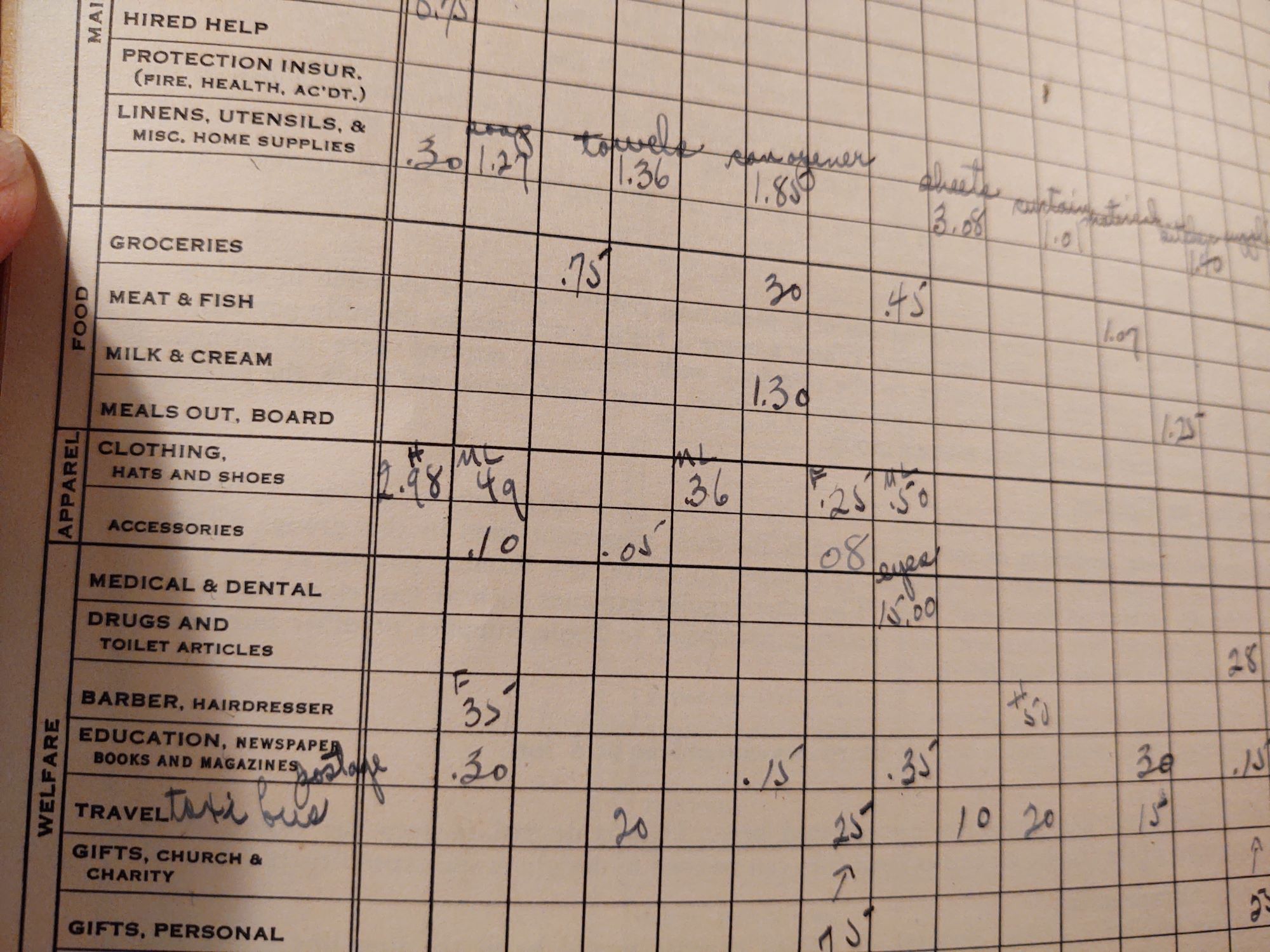
Then Food, Apparel, Welfare.
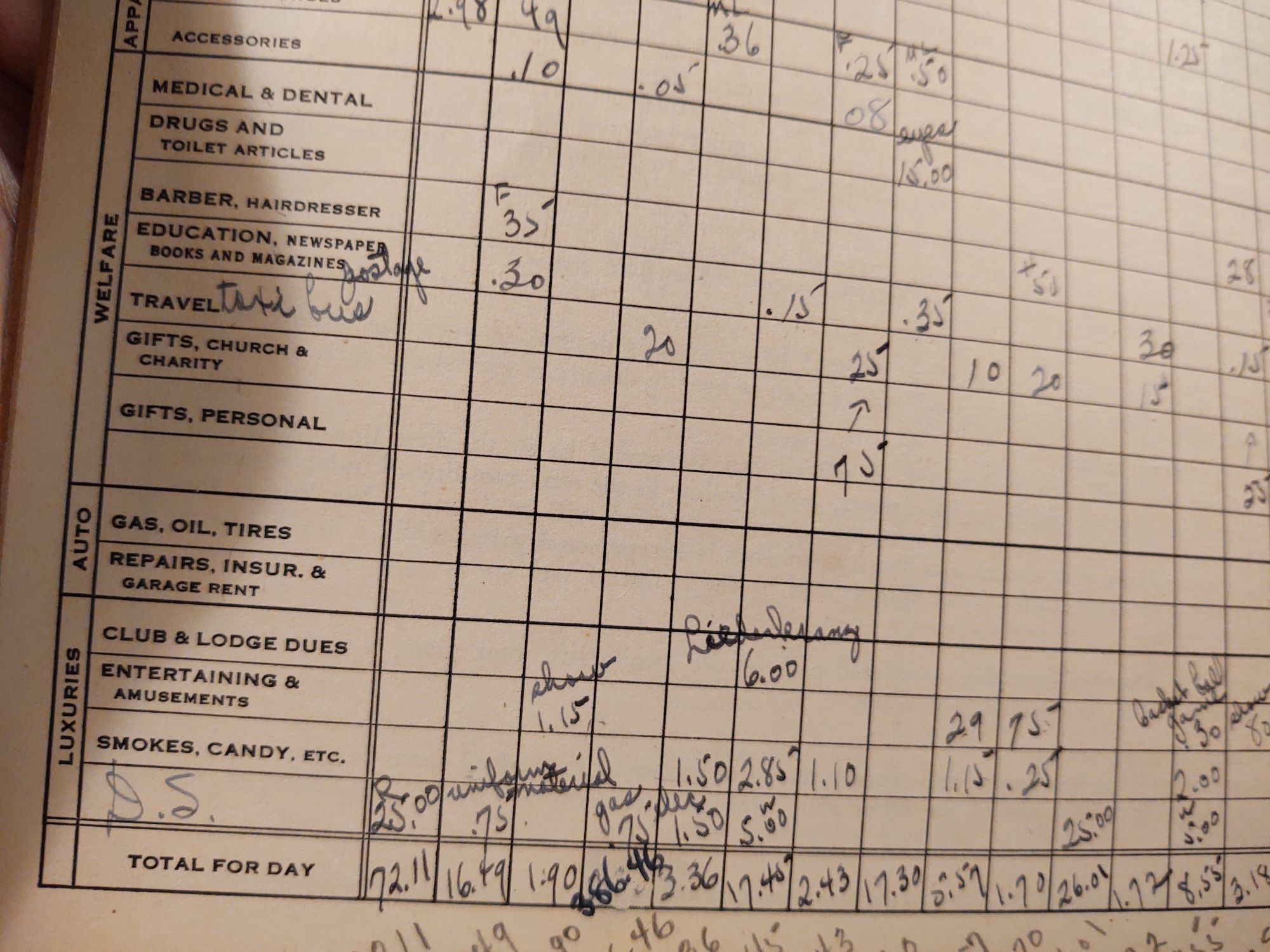
Then we see the rest of the welfare, Auto and Luxuries.
This family spent more than we expected being it was 1940 and reading other budget books similar to these years. We figured that his income was higher than most. There were some strange entries at the bottom of the budget book. it was listed D.S. and each month this line of expenses continued.

The columns are Left to Right, Daddy, Mother, Gladys & Leon and the totals are what they spent on clothing and shoes for the entire year.
After we studied all four budget books I put together all the small scribbles I could find and finally realized that the head of this household was a Dentist. The D.S. was dental supplies.
After scouring the old newspapers with what little information I could gather, I found that they lived in Nebraska.
This is when I realized that we need to know the salaries of all kinds of different occupations if we can understand how people from all incomes were able to afford to live. So back to researching and scouring anything I could find, the government information was too vague and the print was too small to see.
I felt that there had to be a more solid way to find how much people really made and how to convert that in today's time. I started scouring the united states census and started writing as fast as possible because I found that the 1940's census list occupations and salaries and how many hours they worked. I also found out that many professionals had 0 for their income. I do not know the reason some did not list their income. There were some that did so that helped a little.
That all led me to what I was looking for, I needed assorted occupations and incomes.

I did find time to clean the chandelier today.
The inflation calculators say that $1.00 in 1940 is $22.44 today./ $5.00 = $112.21 / $10.00 = $224.41 / $20.00 = $448.82 / $50.00 = $1,122.05 / $100.00 = $2,244.11 / $500.00 =$11, 220.54 / $1,000.00 in 1940 = $22, 441.07 in 2024
I started in Nebraska getting the incomes for the year 1940.
Stenographer 52 weeks per year 42 hours per week $1,440 PER YEAR
Teacher 36 weeks per year 40 hours per week, $1,550 Per Year
State Assistant Supervisor 52 weeks 48 hours per week $1,500 Per Year
Steam Railroad Machinest 52 weeks per year 48 hours per week $1,500 Per Year
Railroad Boiler Maker 52 weeks per year 48 hours per week $1,500 Per Year
Housekeeper Hotel 52 weeks per year 48 hours per week $480 Per Year
Bellboy 52 weeks per year 60 hours per week $240 per year
Photographer Studio 52 weeks per year 48 hours per week $720 Per Year
Metal maker Hardware store 52 weeks per year 48 hours per week $1,000 Per Year
Conductor Steam Railroad 52 weeks per year 48 hrs per week $3,000 Per Year
Bookkeeper Department Store 52 weeks 48 hrs per week $520 (Female)
Electrical Engineer Power Company 52 weeks 48 hrs $2,330 Per Year
Manager life insurance Co. 52 weeks per year 60 hrs per week. $3,600 Per Year
Salesman General foods 52 weeks per year 60 hrs per week $4,031 Per Year
Janitor Public School 52 weeks per year $1.200 Per Year
Sales Lady Dept store 30 weeks per year 34 hrs per week $330 per year
Salesman Automobile 52 weeks year 50 hrs per week $3,000
I am only posting part of what I found because this post would be too long and take a very long time to put everything in. If you have a question of a certain occupation or location just email me a short email or ask in the forum and I will see what I can find.
Then I switched to Alabama
Bookkeeper Jewelry co. worked 52 weeks per year not listed hrs per week $920 Per Year
Clerk Retail Drug store worked 48 weeks per year 26 hrs per week $300 Per Year
Linesman City 52 weeks per year 48 hrs per week $1,040 per year
Clerk 52 weeks per year 48 hrs per week $600
Bookkeeper Seed store 52 weeks per year 48 hrs per week $700 per year
Teacher Public School 52 weeks year 30 hrs per week $1210 per year
Medical Assistant Dr. Office 52 weeks per year 48 per week $700 per year
Mail carrier 52 weeks per year 40 hrs per week $2,100
Then I went to Memphis Tennessee, Utica New York, Orange county California, other states and other counties. I wrote it down in my notebook but too much to type out in this post.
I decided to search for Dentist income since this would be helpful for the budget books. Most Dentist or Doctors did not list their income. However I found a way to look through the census and some Dentist that did list their income. We did some figures to see what the dentist in our budget books would have needed to make for his expenses and savings that he listied and we estimate that in the year 1940 he was making approximately $4,500 per year. That would equal $100,984.82 in 2024.
Here are the incomes that I did find for Dentist that did list their income in the 1940 census.
Dentist, Queens N.Y. 52 weeks per year 52 hrs per week. $5,000 Per Year
Marmaduke Arkansas 26 weeks per year 20 hrs per week $600 Per year He was a 65 year old widowed male.
Queens N.Y Dental Nurse 51 weeks per year 52 hrs per week. $780 Per Year
Washington Dist of Columbia 52 weeks per year 42 hrs per week $4,000 Per year
Boise City Idaho $5,000 per year
Assistant to Dentist in Alaska 52 weeks per year $2,100 Per year
Queens N.Y. 32 weeks per year 30 hrs per week $2,500 per year
Hempstead N.Y 52 weeks per year 54 hrs per week $5,000 Per year
One thing has lead to another, I have found the income for retired folks and then I was off on research for light bulbs and this is when I had a light bulb moment and this is going to be the next post to start us off on our budget. We will get to the Kilowatt questions as well.
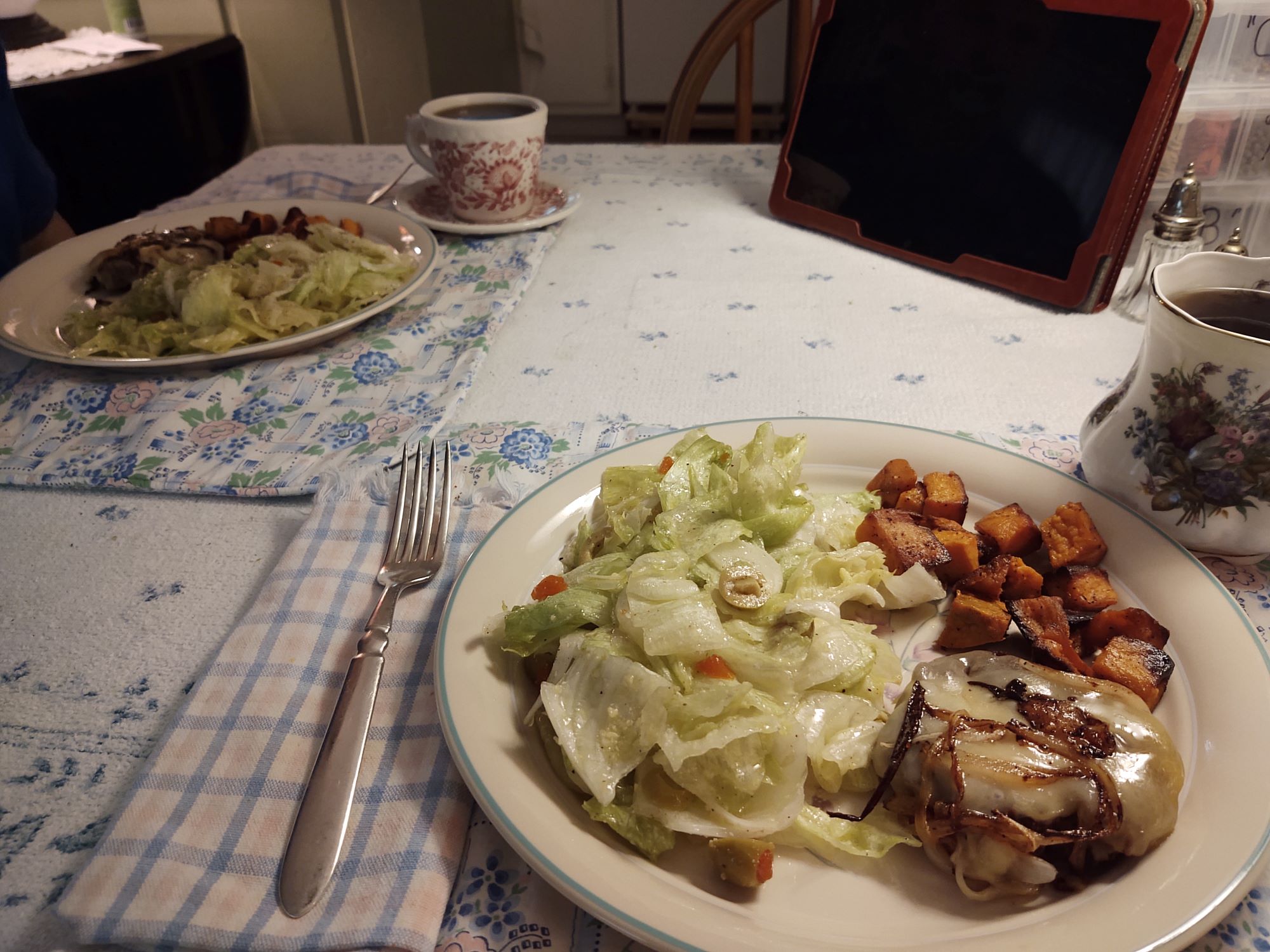
People went to the movies quite often in 1940 since they didn't have television. We don't have television anymore so this is what we do for movie night now. We use our tablet and watch All Creatures Great and Small for a dinner and movie. The series starts in the 1930s and goes into ww2 and we just love it so we can look at the inside of their house. Of course this is a series but they have done a wonderful job of furnishing the house and all of the cookery and dishes and food that Mrs. Hall prepares. :) I think I would stick to tea, if you have ever watched this you will understand. We watch the newer version because that is what we have.
Don't forget to make your envelope book. If you have any questions just ask in the forum or a short email. Start looking closely at your electric bills to find out how much your Kilowatts cost at your location. I would like us to compare in the forum. Our Kilowatts cost almost nine cents per kilowatts here in Dothan Alabama. The power company that services outside our city charges eighteen cents per kilowatt. We need to learn how to watch our Kilowatts.
I will be back with more. Grandma Donna


